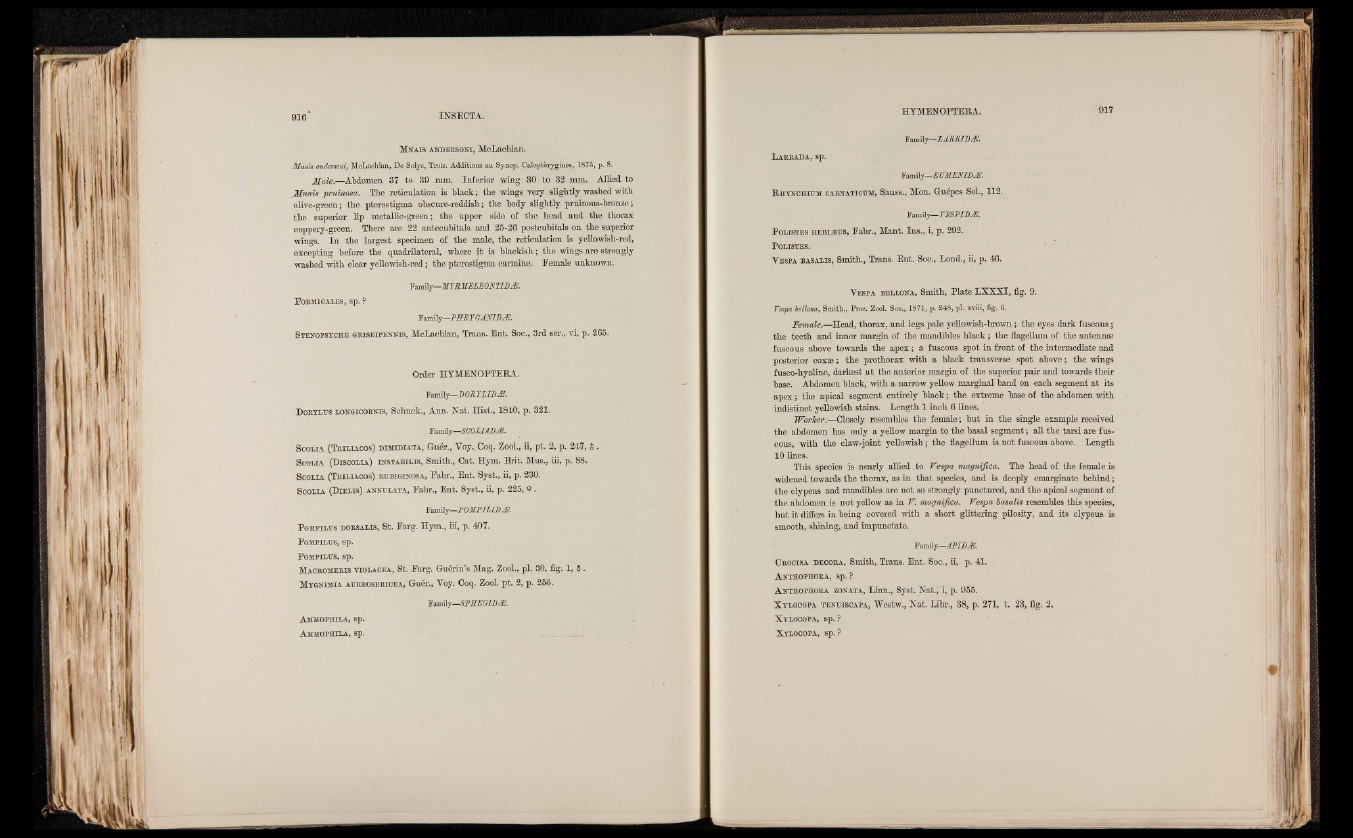
9 1 6 * ÎNSECTA.
M n a is a n d e r s o n i , McLachlan.
Mnais andersoni, McLachlan, De Selys, Trois. Additions au Syuop. Caloptèrygines, 1873, p. 8.
Maie.—Abdomen 37 to 39 mm. Inferior wing 30 to 32 mm. Allied to
Mnais prumosa. The reticulation is black; the wings very slightly washed with
olive-green; the pterostigma obscure-reddish; the body slightly pruinous-bronze;
the superior lip metallic-green ; the upper side of the head and the thorax
coppery-green. There are 22 antecubitals and 25-26 postcubitals on the superior
wings. In the largest specimen of the male, the reticulation is yellowish-red,
excepting before the quadrilateral, where it is blackish ; the wings are strongly
washed with clear yellowish-red ; the pterostigma carmine. Female unknown.
Family—M7RMELE0NTIDÆ.
F o rm ic a l e s , s p . ?
Family—PHRYGANIBÆ.
St e n o p s y c h e g r i s e i p e n n is , McLachlan, Trans. Ent. Soc., 3rd ser., v i, p . 2 6 5 .
Order HYMENOPTERA.
Family—D OR YLIDÆ.
D o r y lu s l o n g ic o r n is , Sohnck., Ann. Nat. Hist., 1840, p. 321.
Family—SC0IIADÆ.
S c o l ia (T r il ia c o s ) d im id ia t a , Guér., Voy..Coq. Zool., ii, pt. 2, p. 247, 3 .
S c o l ia (D is c o l ia ) in s t a b l l is , Smith., Cat. Hym. Brit. Mus., iii, p . 8 8 .
S c o l ia (T r il ia c o s ) r u b ig in o s a , Fabr., Ent. Syst., i i, p. 2 3 0 .
S c o l ia (D i e l i s ) a n nt jla ta , Fabr., Ent. Syst., ii, p . 225, 9 .
Family—P 0MP1LIDÆ.
P om p il t js d o r sa l is , St. Farg. Hym., iii, p. 407.
POMPLLTJS, Sp.
POMPLLUS, Sp.
M a c r o m e r is v io l a c e a , St. Farg. Guérin’s Mag. Zool., pi. 30, fig. 1, &.
M y g n im ia a u r e o s e r ic e a , Guér., Voy. Coq. Zool. pt. 2, p. 256.
Family—SPHEGIDÆ.
Ammophila, sp.
Ammophlla, sp.
HYMENOPTERA. 917
Family—LARRIDÆ.
L a r r a d a , sp.
Family—EÜMENIDÆ.
R h y n c h iu m c a r n a t ic u m , Sauss., Mon. Guêpes Sol., 112.
Family— FRSPIDÆ.
P o l i s t e s HEBIÆUS, Fabr., Mant. Ins., i, p. 292.
POLISTES.
V e s p a b a s a l i s , Smith., Trans. Ent. Soc., Lond., ii, p. 46.
V e s p a b e l l o n a , Smith, Plate LXXXI, fig. 9.
Vespa bellona, Smith., Proc. Zool. Soc., 1 8 7 1 , p. 2 4 8 , pi. xviii, fig. 6.
Female.—Head, thorax, and legs pale yellowish-brown ; the eyes dark fuscous ;
the teeth and inner margin of the mandibles black ; the flagellum of the antennae
fuscous above towards the apex ; a fuscous spot in front of the intermediate and
posterior coxæ ; the prothorax with a black transverse spot above ; the wings
fusco-hyaline, darkest at the anterior margin of the superior pair and towards their
base. Abdomen black, with a narrow yellow marginal band on each segment at its
apex ; the apical segment entirely black ; the extreme base of the abdomen with
indistinct yellowish stains. Length 1 inch 6 lines.
Worker.—Closely resembles the female ; but in the single example received
the abdomen has only a yellow margin to the basal segment ; all the tarsi are fuscous,
with the claw-joint yellowish ; the flagellum is not fuscous above. Length
10 lines.
This species is nearly allied to Vespa magnifica. The head of the female is
widened towards the thorax, as in that species, and is deeply emarginate behind ;
the clypeus «-Tid mandibles are not so strongly punctured, and the apical segment of
the abdomen is not yellow as in V. magnifica. Vespa basalis resembles this species,
but it differs in being covered with a short glittering pilosity, and its clypeus is
smooth, shining, and impunctate.
Family—ÂPIDÆ.
C r o c i s a d e c o r a , Smith, Trans. Ent. Soc., ii, p. 41.
A n t h o p h o r a , sp. ?
A n t h o p h o r a z o n a t a , Linn., Syst. Nat.,' i, p. 955.
X y l o c o p a t e n t j isc a p a , Westw., Nat. Libr., 38, p. 271, t. 23, fig. 2.
X y l o c o p a , sp. ?.
X y l o c o p a , sp. ?